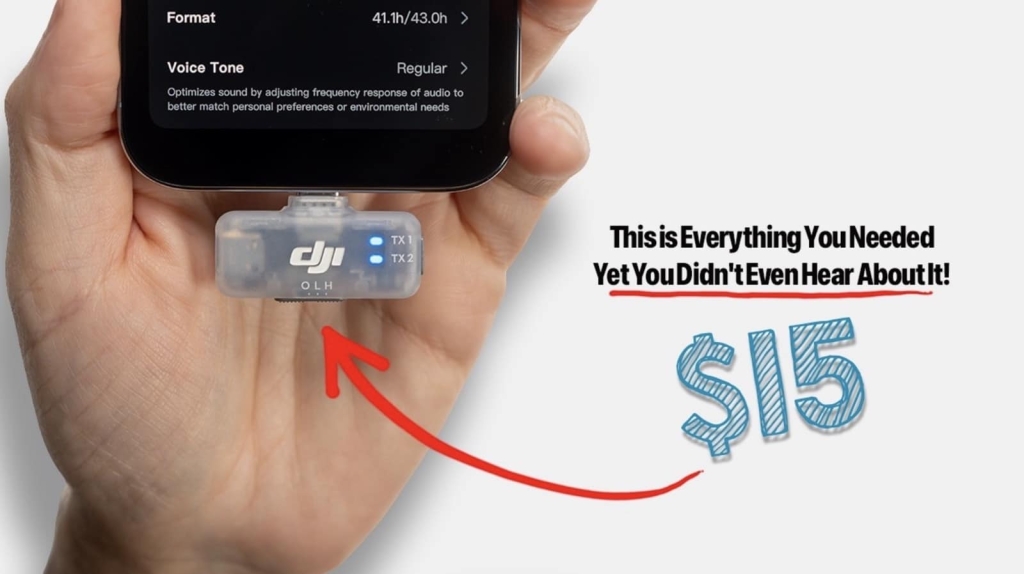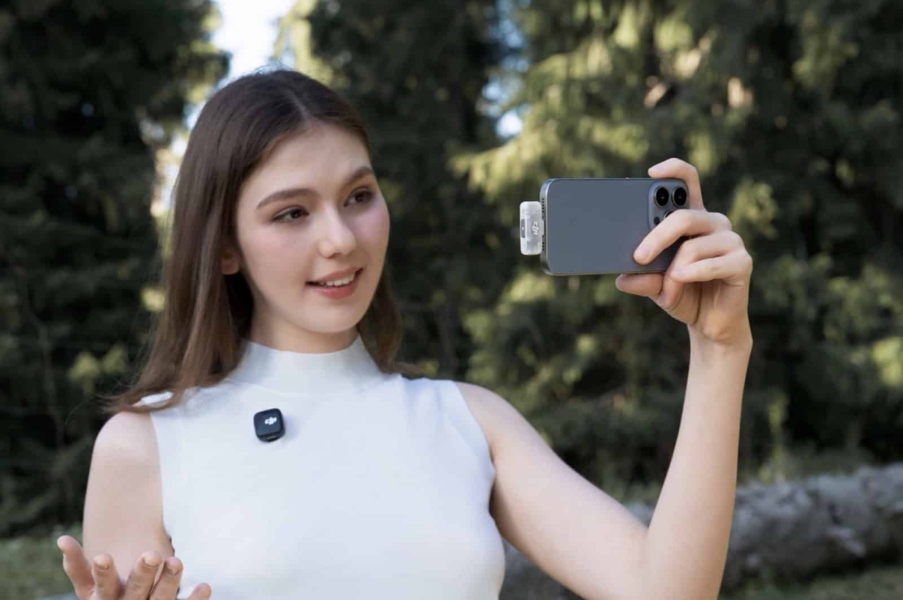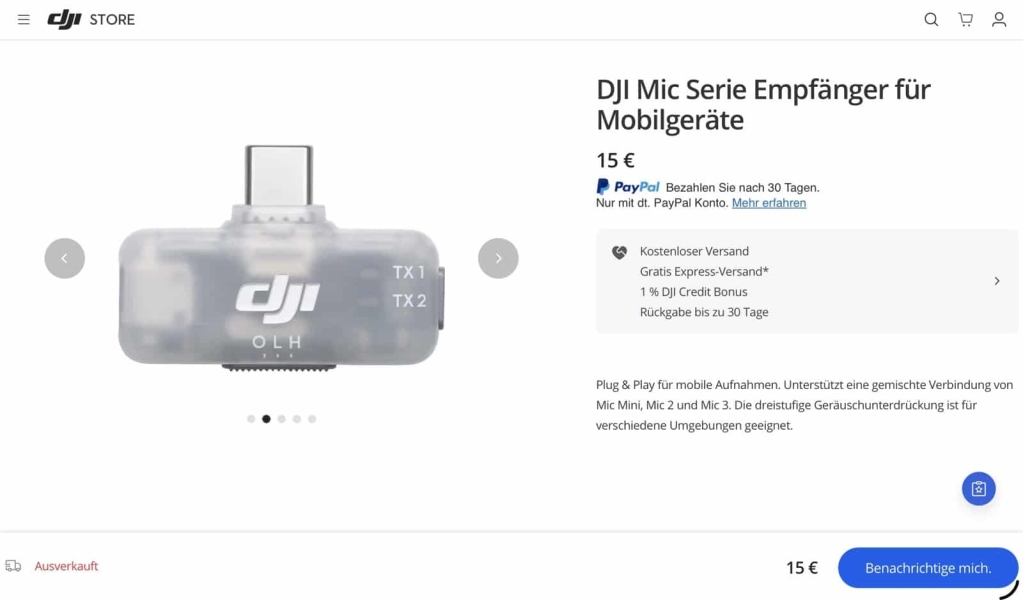DJI’s $15 Mobile Receiver Transforms Smartphone Audio—But U.S. Creators Can’t Buy It

Youtuber iPhonedo has uncovered a quietly released DJI accessory that could revolutionize mobile audio recording—if American customers could actually purchase it. The DJI Mic Series Mobile Receiver, a tiny $15 device that enables wireless microphone connections directly to smartphones, has been available in China since mid-October but remains conspicuously absent from U.S. markets as DJI faces an automatic product ban deadline less than two months away.
The ultra-compact receiver eliminates the need for DJI’s full-sized Mic 2 or Mic 3 receiver units when recording on mobile devices, offering content creators a streamlined workflow at a fraction of the typical cost. Yet the product’s near-invisible launch—hidden in app menus and buried in download pages—combined with zero U.S. availability highlights how regulatory tensions are depriving American creators of accessible audio solutions while Chinese competitors forge ahead.

Discovering DJI’s Secret Mobile Accessory
iPhonedo stumbled upon the DJI Mic Series Mobile Receiver while browsing the DJI Mimo app, where a wireless mic section revealed the previously unannounced product. After contacting DJI representatives, he learned the device had been quietly selling in Chinese and select European stores since October 15, 2025, with virtually no marketing or official announcement.
The creator ultimately sourced one through eBay for $40—nearly three times the $15 retail price in China—after discovering the device wasn’t sold through any U.S. channels. “This is normally $15. I paid $40 for it,” iPhonedo explained in his video, acknowledging the premium reflected both import challenges and the ongoing regulatory uncertainty surrounding DJI products in America.
At just 6.5 grams (0.23 ounces), the mobile receiver measures 39.26×27.26×8.97mm and connects directly to smartphones via USB-C or Lightning adapter. The device supports simultaneous pairing with two transmitters from any combination of DJI Mic Mini, Mic 2, or Mic 3 units—though it’s not compatible with the original DJI Mic.

Professional Features At Consumer Prices
The mobile receiver includes a physical three-position noise cancellation switch offering Off, Basic, and Strong settings—a feature iPhonedo demonstrated works seamlessly without requiring app adjustments. The device operates on both GFSK 2.4GHz and Bluetooth 5.3 protocols, with the creator noting green mode connectivity for Mic Mini and blue mode for Mic 2 and Mic 3 units.
“You can connect two DJI Mic 2, two DJI Mic 3’s or two DJI Mic Minis or you can combine them as you wish,” iPhonedo explained while demonstrating the pairing process, which involves holding the linking button until indicators flash blue and green.
The receiver includes a USB-C port that supports simultaneous phone charging during recording sessions, though iPhonedo couldn’t verify the monitoring port functionality in his test unit. He also demonstrated the receiver’s compatibility with the existing DJI Mic Series Camera Adapter, enabling wireless audio to cameras without cable connections.
Hidden In Plain Sight
Perhaps most puzzling about the mobile receiver launch is how thoroughly DJI buried the product information. The accessory doesn’t appear on main product pages or in promotional materials—instead, customers must navigate to the DJI Mic Mini downloads page and scroll through compatibility documents to find references to the mobile receiver.
iPhonedo questioned this approach directly: “I’m so surprised that it’s not—we never even heard about it. And the thing is this is like hidden in Mic Mini’s page. You have to go to DJI’s website and then find Mic Mini and then if you go to downloads, you can find it there somewhere.”
Official DJI documentation dated October 15, 2025 confirms compatibility with dozens of smartphone models from manufacturers including Apple, Samsung, Huawei, Xiaomi, and OPPO—suggesting DJI invested significant testing resources despite the minimal marketing push.

Regulatory Tensions Block U.S. Access
The mobile receiver’s China-only availability crystallizes the broader challenges facing DJI in American markets. The company faces automatic addition to the FCC’s Covered List by December 23, 2025, unless a federal agency completes a mandated security review—and no agency has confirmed conducting the assessment.
This looming deadline has already created widespread product shortages across DJI’s entire lineup, with the company’s official U.S. store showing most drone models as sold out or on extended backorder. Customs and Border Protection seizures that began in October 2024 have further constrained supply chains.
For content creators, the timing couldn’t be worse. The mobile receiver would complement DJI’s recently launched Mic 3 system, which brought professional features like 32-bit float recording, 400-meter range (1,312 feet), and timecode synchronization to the wireless audio market. The Mic 3 currently retails from $219 for a single transmitter-receiver combo, making the $15 mobile receiver a compelling add-on for smartphone-focused workflows.
iPhonedo directed his frustration at U.S. regulatory policy: “These dark clouds over DJI be gone. And if U.S. wants to go after a Chinese company, why don’t you ask us? Go after [other companies]. Why are you chasing these guys? Leave them alone. We need to get this receiver for $15, not for $40.”
DroneXL’s Take
The DJI Mic Series Mobile Receiver embodies everything frustrating about America’s approach to Chinese technology restrictions. Here’s a genuinely useful $15 accessory that would benefit tens of thousands of content creators, podcasters, and journalists—yet U.S. customers are forced to pay inflated eBay markups or go without entirely, all while lawmakers claim to protect consumer interests.
We’ve extensively covered DJI’s Mic ecosystem evolution, from the budget-friendly Mic Mini to the professional Mic 3. The mobile receiver fills an obvious gap—eliminating the need for full-sized receivers when shooting smartphone content—at a price point that makes professional audio accessible to beginners.
Yet DJI’s near-invisible launch strategy raises questions. Did the company deliberately soft-pedal this release to avoid attracting regulatory scrutiny? Or has the uncertain U.S. market climate made even minor accessory launches too risky to promote? The product’s burial in download pages suggests DJI may be testing waters cautiously, aware that any new FCC filing could trigger congressional intervention.
The broader context matters here. As we’ve documented, DJI has responded to import restrictions by establishing shell company networks like Skyany, Skyrover, and Cogito—brands selling DJI-designed products under alternative names to circumvent FCC barriers. The mobile receiver’s China-only status might reflect similar strategic calculations: why invest in U.S. regulatory approval for a $15 accessory when the entire company could be blacklisted by December?
Meanwhile, American content creators face what we’ve called an accessibility crisis—not just for drones, but across DJI’s entire product ecosystem. The stock depletion affecting everything from Neo to Inspire 3 now extends to accessories that would enhance existing equipment.
This isn’t security policy—it’s market protectionism creating artificial scarcity. If DJI microphones posed genuine threats, why do professional creators worldwide rely on them? The answer is simple: they don’t. But acknowledging that would undermine the narrative driving congressional action.
The mobile receiver’s $15 price tag in China versus $40+ on U.S. gray markets perfectly illustrates how regulatory barriers harm consumers while benefiting exactly no one. American creators deserve access to affordable, quality tools—not artificially inflated prices driven by political gamesmanship.
What do you think? Share your thoughts in the comments below.
